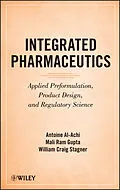Focusing on the application of physical pharmacy, drug design, and drug regulations as they relate to produce effective dosage forms for drug delivery, Integrated Pharmaceutics provides a comprehensive picture of pharmaceutical product design, describing the science and art behind the concepts of dosage form development. Combining physical pharmacy, product design, and regulatory affairs issues in a single book, the authors address topics governing drug regulations of United States, European, and Japanese agencies and detail new regulatory guidelines, including quality by design, design space analysis, and blend sample uniformity.
Autorentext
ANTOINE AL-ACHI, PhD, CT (ASCP), is Associate Professor
of Pharmaceutics in the College of Pharmacy & Health Sciences
at Campbell University. He is also the former head of the
Formulation Development Division of Campbell's Pharmaceutical
Sciences Institute (CUPSI).
MALI RAM GUPTA, PhD, is Associate Professor of
Pharmaceutical Sciences and Director of Pharmaceutical Education
& Research Center (PERC) in the College of Pharmacy &
Health Sciences. Prior to joining the faculty at Campbell
University, he spent twenty-five years in various positions at
Revlon, including director of quality control and assurance.
WILLIAM CRAIG STAGNER, PhD, RPh, is Professor of
Pharmaceutical Sciences and Director of Campbell University's
Center for Analysis of Pharmaceutical Biomaterials. Prior to
joining the faculty at Campbell, he established the Pharmaceutics
Department at Glaxo Research Institute.
Klappentext
An examination of all aspects of the science and art of dosage form development
Integrating physical pharmacy, drug design, and drug regulation, this book examines all the key elements needed to produce effective dosage forms for drug delivery. It begins by setting a solid foundation of physical pharmacy principles such as drug stability estimation, rheology, and interfacial properties. Next, the authors explain how to incorporate these principles into product design. Lastly, the book integrates harmonized pharmaceutical development regulatory guidelines and requirements with the science and technology of pharmaceutical product design in the United States, European Union, and Japan.
Integrated Pharmaceutics offers a comprehensive portrait of pharmaceutical product design, fully describing the science and art of dosage form development. Readers will find clear and thorough coverage of:
- Fundamental physical pharmacy principles and their role in drug product design
- Regulatory science section covering drug regulation, pharmacy compounding practices, manufacturing validation, and quality systems and controls
- Recent regulatory guidelines for quality by design, design space analysis, process analytical technology, polymorphism characterization, blend sample uniformity, stability protocols, and biopharmaceutical classification systems
Each chapter includes a glossary defining key terms and a list of references leading to the primary literature in the field. Many of the chapters also feature case studies, reference appendices, and practical problems, enabling readers to apply the principles set forth in the book to solve common problems in drug product design.
With its comprehensive, multidisciplinary approach, Integrated Pharmaceutics is recommended for graduate-level courses in pharmacy, the pharmaceutical sciences, pharmaceutics, physical pharmacy, drug formulation and design, and biomedicine. The book will also enable professionals in the pharmaceutical industry to apply an effective integrated approach to drug product design.
Inhalt
Foreword xv
Preface xvii
Part I Preformulation
Chapter 1 Mathematical Concepts 3
1.1 Introduction 3
1.2 The Simple Linear Relationship 4
1.3 Exponential Rules 7
1.4 Logarithmic Rules 8
1.5 Differential Equations 10
1.6 Expanding and Reducing Formulas 12
References 13
Glossary 14
Chapter 2 Thermodynamics 15
2.1 Introduction 15
2.2 The Zeroth Law of Thermodynamics 15
2.3 The First Law of Thermodynamics 16
2.4 The Second Law of Thermodynamics 17
2.5 The Third Law of Thermodynamics 18
2.6 Polymorphism 18
2.7 Physical Stability of Crystal Forms 20
2.8 Solubility 21
References 22
Glossary 23
Chapter 3 Solubility and Dissolution 25
3.1 Introduction 25
3.2 Concentration Units 26
3.3 What Should be Done When Alcohol is Prescribed in a Formulation 35
3.4 The Partition Coefficient 36
3.5 Disintegration and Dissolution 38
3.6 Concluding Remarks 43
References 43
Glossary 44
Chapter 4 Biological Aspects of Formulations 45
4.1 Introduction 45
4.2 Bioavailability and Bioequivalence 45
4.3 Protocols for Determining Bioequivalence 49
4.4 Bioequivalence Procedure 49
4.5 FDA-Approved Methods for Bioequivalence Studies 50
4.6 Approaches to Improving Bioavailability 52
References 54
Glossary 54
Chapter 5 Interfacial Properties 57
5.1 Introduction 57
5.2 Liquid–Solid Interface 58
5.3 Dosage-Form Applications 58
References 63
Glossary 63
Chapter 6 Adsorption Phenomenon 65
6.1 Introduction 65
6.2 Adsorption on Filters 68
6.3 Adsorption of Proteins 69
References 70
Glossary 71
Chapter 7 Rheological Principles 73
7.1 Introduction 73
7.2 Newtonian Systems 74
7.3 Non-Newtonian Systems 75
7.4 Viscoelasticity 78
7.5 Reynolds Number 81
7.6 Concluding Remarks 81
References 82
Glossary 82
Chapter 8 Chemical Stability and Shelf-Life Determination 85
8.1 Introduction 85
8.2 Shelf-life Determination 86
8.3 Stability of Biotechnology Products 112
References 113
Glossary 117
Chapter 9 Particle Science 119
9.1 Introduction 119
9.2 Particle Size Estimation and Distribution 120
9.3 Micronization 125
9.4 Particle Size Preparation and Reduction for Pulmonary Delivery 126
9.5 Polymeric Particulate Matter 128
9.6 Nanoparticles 128
9.7 Segregation of Particles 131
References 132
Glossary 133
Chapter 10 Basic Statistics and Design of Experimental Concepts 135
10.1 Descriptive Statistics 135
10.2 Inferential Statistics 137
10.3 Statistical Applications in Quality Control Testing 146
10.4 Design of Experiment 148
References 154
Glossary 154
Chapter 11 Formulation Development Concepts 157
11.1 Preformulation 157
11.2 Scale-up Considerations 158
11.3 Combination Products 159
11.4 Rate-Controlled Drug Delivery 160
11.5 Drug Delivery Technologies for Improving Oral Delivery 163
11.6 Drug Delivery Technologies for Improving Transmucosal Delivery 165
11.7 Drug Delivery Technologi...
